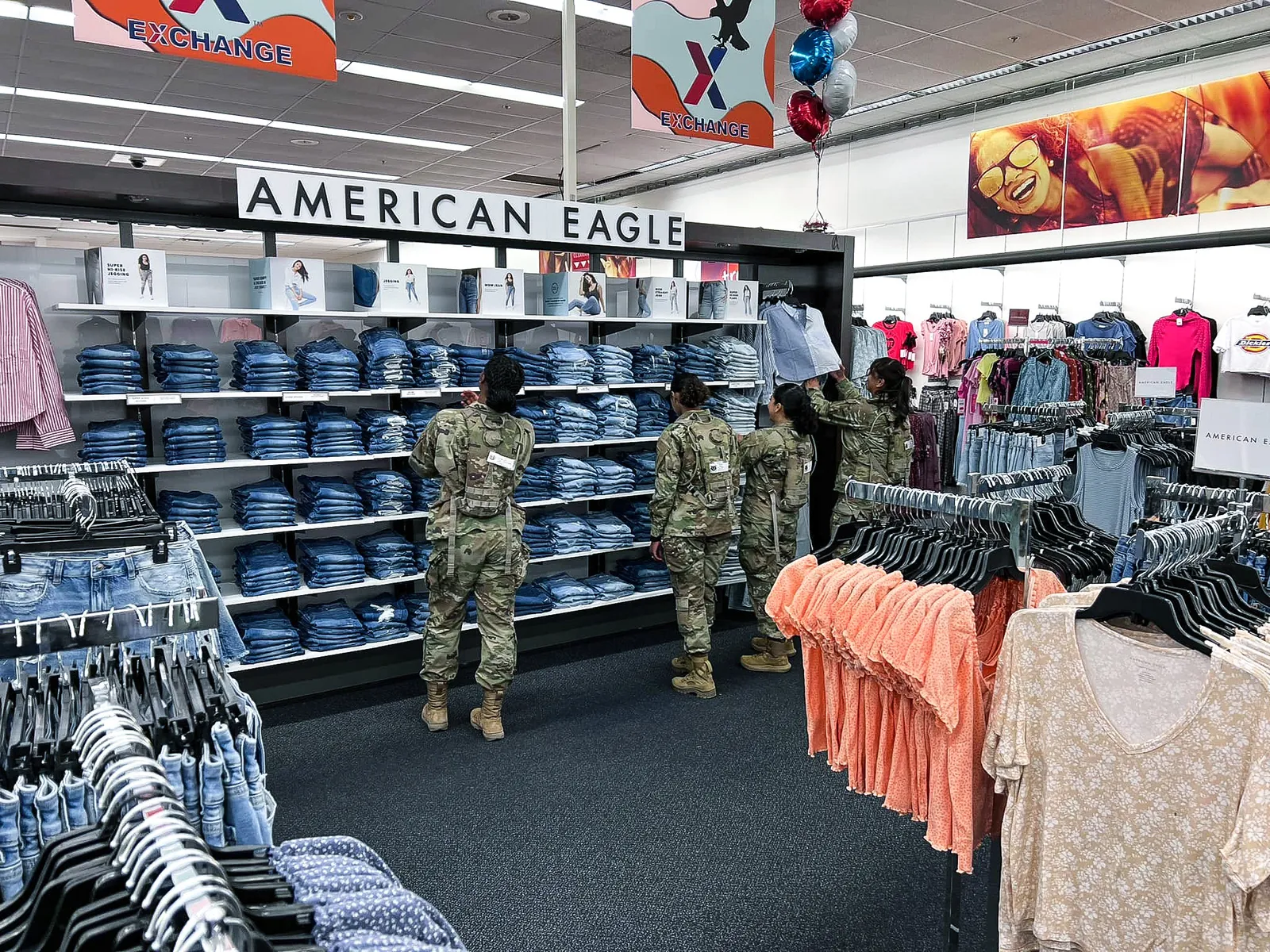More than 33 million customers are eligible to shop at the Army & Air Force Exchange service. That customer base includes members of the military, their immediate family members, retirees and Department of Defense civilian employees.
AAFES, which also brands itself as the Exchange, offers both daily essentials and discretionary items for military members who are stationed in remote locations in the U.S., overseas or even in combat zones.
The Exchange wants to stay top of mind for customers. And it wants to curate a retail experience that meets or exceeds what might be available off base. As part of that goal, AAFES in 2022 added several brands to its apparel and home assortment in stores and online through its e-commerce platform. The brand launches include Old Navy, American Eagle, Fanatics, Sunglass Hut, and Purple mattresses and bedding.

“We want all the brands that the customer is used to and wants,” said Karen Cardin, the Exchange’s chief merchandising officer. Cardin, who started working at the Exchange 32 years ago and has been in her present position since July 2021, said in-store brand launches look different depending on location.
The Exchange operates in all 50 states, four U.S. territories and more than 30 countries. In fiscal year 2022, AAFES reported $8.5 billion in overall revenue, according to the organization’s latest annual report.
AAFES also has a food service operation that includes franchised brands like Burger King. It operates a variety of other retail services including movie theaters, dry cleaning, convenience stores, liquor stores, hair salons and gas stations. On July 25, the Exchange, which is headquartered in Dallas and No. 54 on the National Retail Federation’s Top 100 Retailers list, marked its 128th year in business.
In recent years, the Exchange has focused on growing the list of name brands that are offered to customers in its stores and through its e-commerce platform.
Brand launch breakdown
Cardin said the Exchange tailors its brand launches in response to its needs and customer interests. For example, Old Navy launched in 60 Exchange stores as a store-in-store offering. “It was on shelves and on racks but it had the Old Navy signing and [you] very much knew it was an Old Navy product,” Cardin said.
On the other hand, Cardin said some brands prefer a more phased approach. American Eagle and Aerie’s launch, for example, was introduced in 15 stores in the first quarter of 2022 and another 15 in the second quarter. Instead of a store-in-store presentation, those brands were presented on the shelves with branding and signage.
Cardin said the merchandise assortment will vary depending on if a military installation is primarily a training base for new service members, like Lackland Air Force Base in San Antonio, Texas, which is home to basic training for the Air Force and Space Force.
Other bases may have more service members with young families, civilians or retirees who live off base in the local community but choose on-base retail to take advantage of better deals and tax-free shopping. The Exchange tweaks its offerings depending on those demographics.
Earlier this year, the Exchange announced a partnership with The Home Depot to offer large appliances to eligible shoppers in-store and online. Eddie Fishburne, director of military exchange programs at The Home Depot, said AAFES leadership approached them about two years ago to gauge their interest in taking on the Exchange’s appliance business.
“The partnership provides the Exchange customer with a wider selection of major appliances to choose from, a better delivery and installation experience, and the added benefit of tax-free savings when purchasing through the Exchange,” Fishburne said via email.
The Exchange and Home Depot said they could expand their partnership.
In addition to washers and dryers, fridges, freezers, microwaves and stoves, “we have already begun selling some items in the Exchange brick-and-mortar stores such as the iconic Homer buckets, Home Depot branded (HDX) batteries and soon-to-be HDX totes. We will continue assessing other categories to sell both on shopmyexchange.com and in AAFES stores,” Fishburne said.
Cardin said the Exchange also has additional brand launches in the works. She declined to identify them because the details are still being worked out. But Cardin did say the upcoming launches “will be in a similar vein to what we’ve done in the past.”
“Some will be in-store concepts and some will be things that will be in smaller displays within the store. They will be nationally known brands. And I think it'll be exciting for our customers because they're going to see something similar to what The Home Depot provided with a really trusted brand. And it fills a need for the military members.”
Cardin told Retail Dive the Exchange “has a fairly large partner in the hard goods” sector that they’re working with, along with several brands in the soft goods category that they’re in conversation with as well.
Like other retailers, the Exchange also has house brands for apparel, soft goods and consumables. The Exchange’s house brands include Harbor Home, which offers linens and housewares; Buzz Cuts clothes for boys and Pony Tails apparel for girls.
AAFES says it's the Department of Defense's largest retailer. Cardin said some of the in-house brands are developed in partnership with other Exchanges – the Navy Exchange, the Coast Guard Exchange and the Marine Corps Exchange, which are separate organizations with similar missions and goals.

Military members skew younger in age and are required to stay physically fit, which influences which categories do well with shoppers. For example, consumer electronics and athletic apparel and footwear are the Exchange’s most popular retail categories and brands.
Exchange customers are tech-savvy. “And they love Apple. Apple is always No. 1 for us in our electronics,” Cardin said. Gaming systems, like the Xbox and PlayStation 5 and Samsung TVs are also top sellers. On the apparel side, Nike and Under Armour are top brands.
Building brand loyalty with those who serve
Brand launches are important for increasing brand awareness, brand value and customer lifetime value, which is the amount of money a customer spends with a brand over their lifetime, according to Alexis Taylor, a marketing consultant at Clicksuasion Labs in North Carolina.
Taylor worked for the Marine Corps Exchange for 10 years; the last three years with the organization were in the MCX’s advertising and branding division for the Marine Corps Exchange at Camp Lejeune-New River in North Carolina.
“Previously, shopping with the Exchange system, although reasonably priced, was viewed as purchasing potentially lower quality or lower valued items,” Taylor told Retail Dive in an email. “When consumers can purchase well-known and well-established brands in one place and without sales tax, they are more apt to look to the Exchange as a one-stop shop and prolong their brand loyalty.”
“When consumers can purchase well-known and well-established brands in one place and without sales tax, they are more apt to look to the Exchange as a one-stop shop and prolong their brand loyalty.”

Alexis Taylor
marketing consultant
Taylor said the Exchange system’s challenges include its limited total addressable market.
“However, retirees and their family members retain most shopping privileges for the duration of their lifetimes,” Taylor said. “Therefore, the market size increases each year as members retire and new members join the Armed Forces.” The exchange’s sales model also benefits from offering tax-exempt purchases.
“In an economy where inflation is at a seemingly all-time high, having the ability to offer tax-exempt retail experiences to their market increases the likelihood of increased consumer brand conversion rates,” Taylor said. “Consumers are feeling a decrease in spending power and are more likely to switch the way they shop to manage expenses.”























